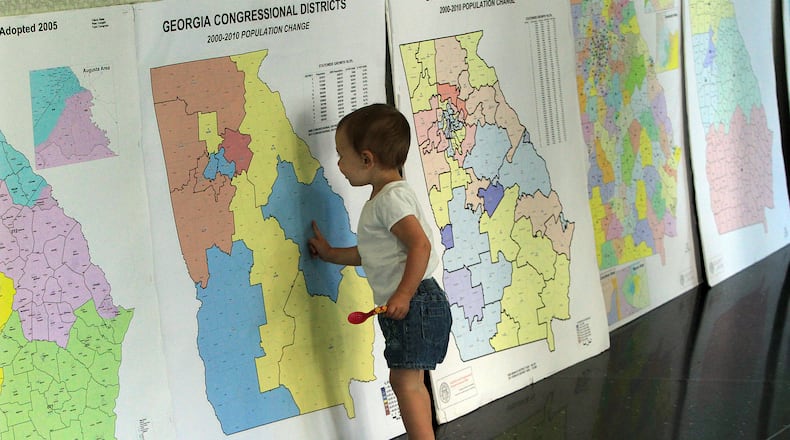Democrat Joe Biden won Georgia’s presidential race by less than a percentage point.
Republican Brian Kemp won the governor’s race in 2018 with 50.2% of the vote.
Census data released this month shows population trends that all point to Georgia moving toward political parity.
So why is it likely, once redistricting is completed this fall, that the state’s balance of power will remain firmly in the hands of Republicans?
While Georgia is a battleground in statewide races, Republicans still wield a solid majority in the General Assembly, where they control 58% of seats, more than enough to approve favorable maps that virtually guarantee reelection in most state House, state Senate and congressional districts.
Republicans’ political dominance in the Capitol gives them disproportionate influence when compared with the GOP’s 51% share of the popular vote from all 2020 general election state races added together.
During public meetings across the state this summer, Georgians told legislators to change a system that they view as unfair and undemocratic.
“Our democracy is harmed when districts are so extremely gerrymandered that only one party has any hope of winning an election,” Julie Bolen, a board member of the League of Women Voters of Georgia, said at a public meeting in Atlanta. “Georgia has been notorious in past elections for having few truly competitive districts.”
The majority party in Georgia and most other states creates unrepresentative districts by choosing where to set the boundaries for seats in Congress and the Legislature. They use mapping software to add or subtract neighborhoods with high concentrations of Republican or Democratic voters, allowing them to achieve desired outcomes before votes are cast.
When Democrats were in power during redistricting 20 years ago, they too attempted to tilt Georgia’s political boundaries to their benefit.
‘That’s the way it’s always been’
Georgia’s population grew by 1 million people during the past decade, primarily in metro areas and the suburbs, according to census data released this month. The number of Black residents has increased by 13% while the white population has dropped by 1%.
Those demographic shifts favor Democrats in the long run but not in next year’s election, especially after legislative and congressional districts are remapped.
Republicans currently hold 57% of state House seats, 61% of the state Senate and an 8-6 lead in the state’s congressional delegation. Those GOP margins could increase after redistricting in elections next year, reversing gradual Democratic gains in recent years.
Redistricting will likely limit the impact of Georgia’s population changes during next year’s elections, said Alan Abramowitz, a political science professor at Emory University.
“I don’t think anyone thinks that rules drawn up by the party in control are necessarily fair,” Abramowitz said. “You might say, ‘Well, that’s the way it’s always been,’ and that’s sort of true, but that doesn’t make it fair either.”
The majority’s authority is constrained by a few main rules: Each district must have equal population under the “one person, one vote” rule established by the U.S. Supreme Court in 1964, and federal law prohibits maps that discriminate on the basis of race.
But the Supreme Court has upheld redistricting for partisan purposes, enabling majority Republicans in Georgia to weaken minority Democrats who often receive about 90% of the Black vote.
And this year, Georgia’s maps won’t need approval from the U.S. Department of Justice, since the Supreme Court in 2013 released states with a history of discrimination from federal oversight. The Democratic-controlled U.S. House advanced a bill Tuesday that would reinstate federal review of changes to election laws in some states. The legislation, however, faces a likely Republican filibuster in the Senate that would prevent it from becoming law.
Republicans say the process will be fair because they’ll follow the law, listen to public feedback and hold public committee hearings before they vote on maps. Kemp hasn’t announced when legislators must return to the Capitol for redistricting, but the session is expected in October or November.
“We plan on being as transparent as we possibly can,” said Senate Majority Leader Mike Dugan, a Republican from Carrolton. “Everybody wants to be sitting in the room — all 11 million Georgians — but we don’t have a room big enough for that. So we’ll be as transparent as we possibly can.”
Adam Kincaid of the National Republican Redistricting Trust, the party’s primary mapmaking organization, said Georgia’s redistricting process must adhere to state and federal criteria set in statute.
“We don’t think that proportionality or proportional representation is the right metric to use to analyze whether maps are fair or not,” said Kincaid, the organization’s executive director. “Republicans have the governorship and they have both chambers of the Legislature and have the responsibility under the Constitution to draw the state’s legislative and congressional maps.”
Credit: Jason Getz
Credit: Jason Getz
Democrats take issue with the idea that following the law justifies unrepresentative district lines.
Theron Johnson of the group All On The Line said Republican legislators should avoid “map manipulation” that divides counties and leads to noncompetitive elections. All On The Line is a campaign of the National Redistricting Action Fund, an affiliate of the National Democratic Redistricting Committee.
“Georgia and the rest of the country is becoming more diverse and more increasingly concentrated in urban and suburban areas. That scares some Republicans,” Johnson said. “The fact is, the state has now become evenly split, and that dynamic ought to be reflected in our state Legislature and our congressional delegation.”
Johnson said Georgia’s congressional districts should give voters an opportunity to elect seven Democrats and seven Republicans, representation that aligns with the nearly 50-50 makeup of the state’s voters.
A shrinking majority
Georgia has steadily leaned more Democratic in recent elections, gradually growing tighter over the past 10 years.
Kemp defeated Democrat Stacey Abrams 50.2%-48.3% in 2018. Biden won 49.5% of the vote to Republican Donald Trump’s 49.3% last year. Republicans have a larger advantage in state legislative races with a cumulative 53%-47% edge in the popular vote.
More equitable maps wouldn’t necessarily result in an even split between Republicans and Democrats, said University of Georgia political science professor Charles Bullock, who wrote “Redistricting: The Most Political Activity in America.”
Because Democrats tend to live in dense urban areas, they aren’t as distributed across the rest of the state, giving Republicans a natural advantage across Georgia’s 180 state House districts and 56 state Senate districts.
Many voters are familiar with gerrymandering, the process of manipulating political boundaries to give the majority party an advantage.
But gerrymandering is harder to see by the naked eye today than it was in past decades, when strangely shaped districts made winding turns across the landscape or cut through counties along a highway, said Ken Lawler, chairman of Fair Districts GA, an advocacy group seeking fair and transparent redistricting.
These days, districts are usually drawn in more recognizable blocks that are more likely to survive court challenges while still achieving politicians’ goals of picking and choosing voters.
“The tools have become so elegant and so powerful that the surgery is done deep down. The damage is done in secret and hidden,” Lawler said. “Election results are how you can tell. We’re a 50-50 state when you look at statewide votes, but when you look at it district by district, it’s not that way.”
Senate Minority Leader Gloria Butler said the Republican majority should create equitable maps that reflect the political preferences of Georgia voters.
“I’m concerned about the whole process. They can do whatever they want,” said Butler, a Democrat from Stone Mountain. “I’m hoping that they will keep the citizens of the state as their No. 1 priority and let the citizens choose the person they want to represent them.”
Disparities in democracy
Most states are like Georgia, giving state legislatures the sole power over redistricting.
Fifteen states assign responsibility for redistricting to commissions, which are often bipartisan and appointed by legislative leaders, political parties or retired judges. Efforts by Democrats in Georgia to create a redistricting commission haven’t advanced in the General Assembly.
“We should have representation that reflects the composition of the state,” said Aunna Dennis, executive director for the government accountability organization Common Cause Georgia. “That could mean districts that look more red, more purple or more blue. That should be a reflection of the ideology of the community.”
Both major political parties benefited from redistricting when they were in power.
After Democrats redistricted the state in 2001, they temporarily slowed their losses in the General Assembly as Republicans began to win Georgia’s popular vote. Republicans took over the state Senate after the 2002 elections and the state House after the 2004 elections.
Then after redistricting in 2011, the GOP solidified its control by winning about two-thirds of each chamber in the General Assembly, gaining four more seats in the House and two more in the Senate.
Just as Democrats couldn’t save their majorities 20 years ago, Republicans might eventually lose power as well, Bullock said. Redistricting alone is unlikely to stave off changes in Georgia’s growing and diversifying electorate in the coming years.
“Pigs get fat and hogs get slaughtered. The Democrats were hogs and they got slaughtered, and I think there’s a good chance it’ll happen to Republicans later on this decade if current patterns continue,” Bullock said. “As voter preferences change, outcomes change.”
— Staff writer Maya T. Prabhu contributed to this article.
A changing Georgia
2010: Nathan Deal (R) 53%, Roy Barnes (D) 43%
2012: Mitt Romney (R) 53.3%, Barack Obama (D) 45.5%
2014: Nathan Deal (R) 52.8%, Jason Carter (D) 44.9%
2016: Donald Trump (R) 51.1%, Hillary Clinton (D) 45.9%
2018: Brian Kemp (R) 50.2%, Stacey Abrams (D) 48.8%
2020: Joe Biden (D) 49.5%, Donald Trump (R) 49.3%
About the Author
Keep Reading
The Latest
Featured








